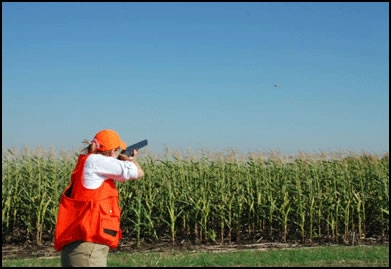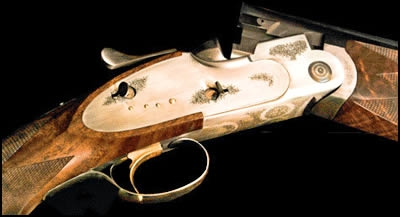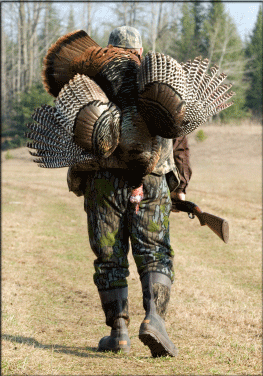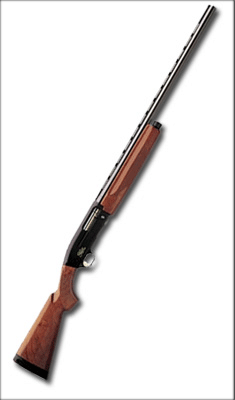In anticipation of the upcoming turkey season, I’m sure most of you have noticed that outdoor print media and television airwaves are filled with scene after scene of toms getting annihilated by 12-gauge and 10-gauge shotguns spewing magnum loads, and the advertisements in between the pages and during the commercial breaks are filled with supercallifragilistic, triple-Xtra, super-duper magnum this, that, and the other. Sheesh, you’d think a turkey had the armor plating of a rhinoceros, rather than a coat of feathers.
Part of the problem has been that the bigger-is-always-better approach has long defined the mindset of more than a few Americans. We’ve seen that philosophy exacerbated in more than a few areas. Take, for instance, the ever-increasing size of our SUVs and trucks. Remember when a Toyota Tundra was the size the Tacoma is now, and when the Tacoma was the size of a Ford Ranger? Or how about Dodge’s Durango, which used to be Chevy Trailblazer size and now rivals a Tahoe for girth. Housing, too, became oversized (naturally, with bigger garages to accommodate our bigger vehicles). And then there’s the glut of television reality shows that tell of sweet-sixteen parties that cost hundreds of thousands of dollars, housewives that think nothing of hopping on a private jet to do a “little” shopping in the next city over, and other glitzy examples of largesse living.

At the end of a great day.
I hate to say it, but the gun industry has followed suit. Think of all the Super Short Magnums that have come on the market in the last decade or so. There was a resurgence of the 10-gauge in recent years, too. Even the archery side of things has its extremes. When I was working at the NRA, we never talked about someone in print claiming to make a clean kill shot on game at more than 40 yards. Yet today, there’s more than a few hardcore archers who know their equipment and have solid skills and will tell you they regularly kill at up to 80 yards (I don’t know, maybe the braggings gotten bigger, too). Still, one of the segments that pushes excess the hardest are the purveyors of guns and ammunition designed particularly for killing turkeys.
I get it, it’s marketing. Kill it further out! Kill it faster! Kill it deader than dead! Now, I’m all for a fast kill, and I have seen where advancing ammunition technology really does result in a faster kill. I remember when some of Federal’s first tungsten shotshells came out, for instance. I took those loads goose hunting, and without question saw a better quality, faster kill than I did with steel shot (airborne geese hit with those loads responded like a bug hitting your car windshield as you cruise down the highway—they never knew what hit them). But I haven’t seen the same results with turkeys. The push for 3 ½-inch 12- and 10-gauge shells that can reach out and tag a tom at 50 or 60 yards is fine in and of itself, but in my opinion it’s unnecessary. I’ll tell you why.
Ask yourself this: are turkeys harder to kill now than they were 20 years ago? No. Do you need to kill a turkey at 60 yards? No. Do you need the recoil of a long-shelled 12- or a 10-gauge bruising your shoulder and cheek? Still nope.
Let me break those questions down for you a little better. The first one is simple enough. Turkeys aren’t any harder to kill or “better educated” now than they have been before. Can they become call shy? Sure, but when the spring season for them lasts, on average, four to six weeks, they don’t become over-exposed like migrating geese and ducks do that have seen and heard it all by the time they end their months-long trek from north to south. So while the argument for magnum loads in waterfowling has a distinct application – pass-shooting call- and decoy-shy geese at the end of a long and liberal season – it falls flat for turkeys.
How about the need to kill a turkey at 50 or 60 yards? “Need” being a relative term, I’d say that, if you find yourself shooting toms as distances much farther out than you ever used to, you need to practice your calling and decoying skills. Yes, turkeys hang up. No, sometimes they can’t be worked closer. Live hens compete with your fakery for a tom’s attention and love and often wins. Crows distract and confuse. That is the romance that is hunting – hunting – this game bird. You have six weeks and one or two tags. I’d rather spend several beautiful spring mornings watching the sun come up and call a gobbler in the right way and close enough for an instant-death, one-shot kill, than plunk a tom down way in the distance on opening day (or any day, for that matter) just because the shot string from my gun reached that far. Just because you can doesn’t mean you should.

The Browning Gold is my turkey gun of choice.
Finally, recoil is absolutely an issue with 12- and 10-gauge shotguns loaded with 3½-inch shells. I know some of you are thinking “Heck, it’s just one, maybe two shots.” But it’s not. You have time on the bench with different chokes and dozens of shells shucked through your gun, if you’re responsible about patterning a shotgun you intend to kill live game with – and if you intend to kill a thickly feathered 20-pound or better bird at 60 yards, you damn well better perfect your gun on paper before you head for the field.
But if you spend the time on the bench that you should, the chances are you’re going to start to flinch, especially if you conventionally and regularly shoot shotguns with less strength. I don’t care how tough you are, how much testosterone courses through you, and how big your truck is, this is physics, and hard-recoiling guns, most often those shot infrequently, do things to you mentally and physically.
Even worse than a flinch, though, is your shot-to-shot recovery. Remember you were thinking “one, maybe two” shots? If you’re going to shoot at distance, the faster a suddenly necessary secondary shot comes the better, and speed in getting the bead or scope back on target following the muzzle rise from the first shot is compromised when you increase the load.
Need one more reason? I’m going back to the how-tough-you-are argument. Plain and simple, there isn’t anything pleasurable about the recoil from these guns. If you say there is, okay for you, but I think that qualifies you as a masochist, and that’s not an attractive trait no matter how you slice it.
If you’re still not convinced, I’d tell you to go back to watching all the turkey hunting shows on TV. Notice the abundance of youth hunts filmed? Take a look at what all those kids are shooting. It’s the 20-gauge. That’s right, the no-notoriety, lil’ ol’ yellow-hulled 20-gauge. Notice anything else? These kids and their small shotguns kill turkeys just fine, especially when an adult with calling skills and hunting skills has called one in close enough. (Get it? Called. In. Close. Enough.) So if the lowly 20-gauge is good enough for your kids to kill a gobbler with, why do you need to buy into the magnum hype?

Beretta’s White Onyx.
I say don’t. Personally, I often carry a 12-gauge auto, an older Browning Gold I’ve owned for some time. It’s super easy on recoil, even with a stiff turkey load, but when I go after gobblers I load it with either 2¾- or 3-inch loads, not the 3½. I don’t need the bigger shell. Maybe more often than I take out the Browning, though, I have a little Beretta White Onyx over/under in 20-gauge that’s my favored tool for turkeys. It’s more maneuverable, fast to reload, accurate as any other shotgun when patterned correctly, and easy to carry if I have to do some hiking for a tom. And it kills just fine.
Try it, try something smaller, like the 20-gauge your kids are hunting with. Resist the temptation to up the distance at which you kill. Resist the marketing hype that bigger is better just because it’s bigger and work on what really should be better, and that is your scouting, calling, and setup techniques. It’s okay to be a magnum hunter, just do it without the magnum gun.
Jennifer L.S. Pearsall is a professional outdoor writer, photographer, and editor, who has been a part of the hunting and shooting industries for nearly 20 years. She is an avid clays shooter, hunter and dog trainer. Please visit her blog “Hunting the Truth” at http://huntingthetruth.com.















